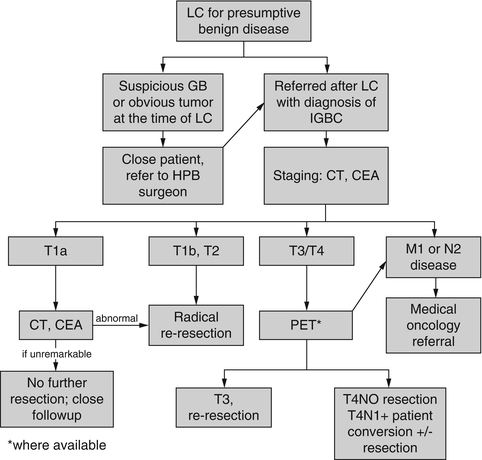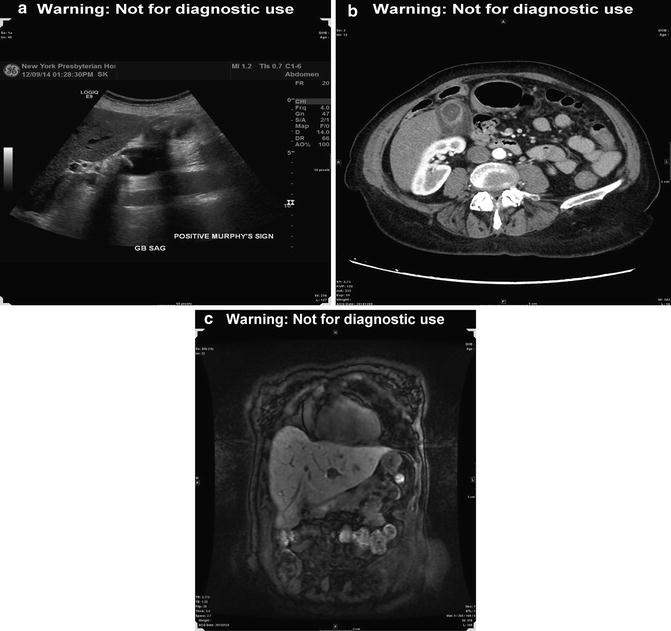Primary tumor
TX
Primary tumor cannot be assessed
T0
No evidence of primary tumor
Tis
Carcinoma in situ
T1
Tumor invades lamina propria or muscular layer
T1a
Tumor invades lamina propria
T1b
Tumor invades muscular layer
T2
Tumor invades perimuscular connective tissue; no extension beyond serosa or into liver
T3
Tumor perforates the serosa (visceral peritoneum) and/or directly invades the liver and/or one other adjacent organ or structure, such as the stomach, duodenum, colon, pancreas, omentum, or extrahepatic bile ducts
T4
Tumor invades main portal vein or hepatic artery or invades at least two extrahepatic organs or structures
Regional lymph nodes
NX
Regional lymph nodes cannot be assessed
N0
No regional lymph node metastasis
N1
Metastases to nodes along the cystic duct, common bile duct, hepatic artery, and/or portal vein
N2
Metastases to periaortic, pericaval, superior mesenteric artery, and/or celiac artery lymph nodes
Presentation
With incidental gallbladder cancer representing the majority of all gallbladder cancer in the USA, one must question why it is not discovered more often preoperatively [4]. Patients are often symptomatic with right upper quadrant pain that appears to be due to cholelithaisis or acute/chronic cholecystitis. Imaging usually notes the gallstones and may also suggest thickening of the gallbladder wall usually without peri-cholecystic edema. Gallstones represent the most prevalent risk factor with over 75 % of patients with gallbladder cancer having associated gallstones [3, 5]. This association leads to the lack of preoperative diagnosis since the incidence of gallbladder cancer in resected cholecystectomies is only 1 % [6]. Certainly, the presence of gallstones is a risk factor for gallbladder cancer. In another series, 90 % of cases of incidentally discovered GBCA had gallstones compared to only 13 % of non-incidental [4].
Incidentally found gallbladder cancer is much more likely to be early stage than cases diagnosed preoperatively using ultrasound, computed abdominal tomography, magnetic resonance imaging, or magnetic resonance cholangiopancreatography scans. Right upper quadrant ultrasound, routinely used for evaluation of symptomatic patients, might show a polypoidal gallbladder mass and potentially invasion of adjacent structures. The presence of gallbladder calcification, also known as “porcelain gallbladder,” may also be noted preoperatively. Wall thickness greater than 3 mm and increased vascularity of the gallbladder are considered sonographic features that can also signify possible malignancy [7].
During open routine cholecystectomy, which was standard procedure decades ago, surgeons might have felt an area of abnormality in the gallbladder during the operation and send the tissue for frozen section examination. Laparoscopic cholecystectomy often misses the incidental cancer during cholecystectomy due to the inability of the operator to actually “feel” the gallbladder and note focal abnormalities during removal. The tactile feedback afforded by a surgeon’s hands appreciating a thickened, infiltrated, incidentally malignant gallbladder is lost in the laparoscopic technique. Unless the surgeon, thoroughly exams the gallbladder upon its removal, the diagnosis is not made for several days when the histologic examination of the tissue is complete.
If gallbladder cancer is not detected while the gallbladder is in situ, the treatment may be compromised. Adenocarcinoma of the gallbladder, in its early focal growth pattern invades into the lamina propria, followed by invasion into the deeper submucosal area and then advances diffusely throughout the gallbladder in the subserosal plane. If the surgeon does not suspect the diagnosis intraoperatively and perform a deep, wide excision of the gallbladder, the subsequent dissection may occur in the subserosal plane and leave cancer cells behind upon separation of the gallbladder from the liver. When this event occurs, incidentally discovered gallbladder cancer patients should undergo careful evaluation to determine the margins and likelihood of recurrence to determine the next best form of management after they have undergone a potentially incomplete cancer operation. Having a high risk for residual disease in the gallbladder fossa and a major risk of cancer seeding of the abdomen at the time of cholecystectomy should be considerations when further extirpative surgery is contemplated.
Detection of Incidentally Discovered Gallbladder Cancer
The surgeon’s diagnosis of incidental carcinoma of the gallbladder intraoperatively is rare (0.1 %), especially when the procedure is performed laparoscopically. In a retrospective review of 3,050 patients undergoing laparoscopic cholecystectomy for cholelithiasis, carcinoma of the gallbladder was discovered during or after laparoscopic cholecystectomy in 10 patients. Interestingly, laparoscopy was converted to an open procedure in only three patients after pathologic diagnosis was confirmed using frozen section [6]. If signs of malignancy are encountered during laparoscopic cholecystectomy, the surgeon should convert to an open procedure [3, 6]. As noted above, the lack of tactile sensation during laparoscopic cholecystectomy makes intraoperative assessment of malignancy quite difficult. A retrospective review of nearly 300 cases of laparoscopic cholecystectomy in which there was suspicion of gallbladder cancer, and frozen section was performed, the incidence of gallbladder cancer was only 1.3 %.
A thickened, infiltrated, or porcelain gallbladder should raise an index of suspicion for the surgeon. Preoperative imaging demonstrating porcelain gallbladder or polypoid lesions of the gallbladder are indications to examine the gallbladder closely intraoperatively for the possibility of malignancy. Among patients presenting with polypoid lesions of the gallbladder, the incidence of cancer is reported to range from 4 to 18 % [8]. Because of this association, patients with porcelain gallbladders should undergo frozen section examination of the gallbladder upon removal if a tumor is not detected intraoperatively by the surgeon.
If an early malignancy (pT1) is diagnosed intraoperatively, no additional resection is required if there has not been a perforation of the gallbladder. If inadvertent gallbladder perforation occurs during its removal, the peritoneal recurrence rate of gallbladder cancer is likely to be increased. In patients with pT2 (into perimuscular fibers) and beyond, hepatic resection of the gallbladder fossa, segmental hepatic resection, and complete dissection of the lymph nodes along the hepato-duodenal ligament (around the bile ducts, hepatic arteries, and portal vein from the hilus of the liver to behind the duodenum and pancreas) is indicated [6, 8, 9]. There are multiple issues to be considered in this situation such as obtaining operative consent for a much larger and unanticipated procedure, the patient’s existing comorbidities and the skill required by the operating surgeon to perform this more complex procedure. Due to these issues, the operating surgeon should decide whether the better option is to perform an open radical resection or whether to close without attempts of resection. When faced with an unexpectedly malignant gallbladder, it is highly recommended that the operating surgeon obtain additional help from a specialty-trained surgeon if the original surgeon is not trained in the more complex surgery. The patient must then be referred for further oncologic work up and potential operative planning for resection (Fig. 17.1).


Fig. 17.1
Management algorithm for patients with incidental gallbladder carcinoma. LC laparoscopic cholecystectomy, BG gallbladder, IGBC incidentally discovered gallbladder cancer, HPB hepato-pancreatico-biliary, CT computed tomography, CEA carcinoembryonic antigen, PET positron emission tomography. Used with permission: Belin, Laurence J., Christina E. Lewis, and Yuman Fong. “Management of Incidental Gallbladder Carcinoma.” Carcinoma of the Gallbladder: The Current Scenario. New Delhi: Elsevier, 2014. 54–66. Print. ECAB Clinical Update Surgical Gastroenterology and Liver Transplantation
Incidentally Discovered Gallbladder Cancer by Pathologic Review
Most commonly, incidental gallbladder cancer is diagnosed after histologic examination of the gallbladder by the pathologist postoperatively. In many cases, the patient has already been discharged from the hospital and has expected no further gallbladder treatment (see Fig. 17.2 and its description of what is a typical case). For the pathologist and the surgeon, the site of the malignancy in the gallbladder and the pathologic stage must be carefully determined to counsel the patient on appropriate further therapy. Review of the histology by another experienced pathologist or at a tumor board is critical because some stages of disease do not require further surgical therapy. For example, patients with pT1a tumors do not benefit from additional treatment as their prognosis is good. Additional operative resection in patients with stage pT1a incidental gallbladder cancer did not result in better survival when compared with patients who had the initial cholecystectomy performed without additional treatment. Patients with more advanced stages of disease (pT2 or greater), however, may well benefit from additional treatment such as re-resection [10].


Fig. 17.2




Seventy-three-year-old female presenting with right upper quadrant pain initially thought to be acute cholecystitis. Patient underwent laparoscopic cholecystectomy. Pathology revealed invasive adenocarcinoma of the gallbladder with high-grade dysplasia and invasion of perimuscular connective tissue (T2, Nx). (a) Preoperative right upper quadrant ultrasound image showing thickened gallbladder wall (9 mm), multiple gallstones, and sludge with normal intraheptatic ducts. Impression read as acute cholecystitis. (b) Preoperative axial CT-scan of abdomen showing 2.0 cm gallstone within the gallbladder neck. This is associated with gallbladder wall thickening/edema and pericholecystic fluid. Mild enhancement of the hepatic parenchyma adjacent to the gallbladder was also noted. No intra- or extra-biliary ductal dilatation was seen. (c) Postoperative coronal MRCP image after the patient was found to have incidental gallbladder cancer with acute cholecystitis. Slightly abnormal signal in the subcapsular portion of hepatic segment 5 in the gallbladder fossa, possible tumor invasion. No clear residual tumor at the level of the cystic duct remnant. No tumor involvement of the common hepatic or common bile duct was noted on pathology
Stay updated, free articles. Join our Telegram channel

Full access? Get Clinical Tree








